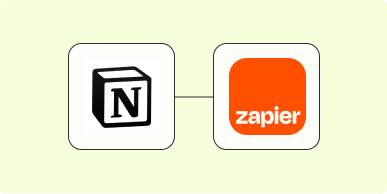Tracking things in too many places? Notion brings together features and functions from apps like Airtable, Asana, Google Docs, and more into one streamlined app so you can simplify your work.
And when you pair Notion with Zapier, you can streamline your work even further. With our automated workflows (we call them Zaps), you can send important information from other apps to your Notion workspace—no coding necessary.
Whether you’re a Notion power user or you’re just getting started with the app, we’ve collected a few Zaps to help you make your Notion workspace a true one-stop shop for your most important information.
You’ll need a Zapier account to use the workflows in this piece. If you don’t have an account yet, it’s free to get started.
Table of contents
How the integration works
Triggers
The Notion integration has one trigger—the event that can start a Zap. You can have Zapier start an automated workflow whenever there’s a new database item in your Notion workspace. You can specify which database or property Zapier should watch to start your Zap.
Searches
There are three searches available for the Notion integration:
-
Find Database Item: Zapier will look for an existing database item in your workspace. You can add additional steps in your Zap to make a change the database item or send information from your database item elsewhere.
-
Find or Create Database Item: This will locate an existing database item in your Notion workspace. If it doesn’t exist, Zapier will create a new database item if you tell it to.
-
Find Page: Zapier will search for a page in your Notion workspace.
Actions
The Notion integration also has three actions—the event your automated workflow performs in Notion. You can search for an item in a Notion database by property. You could use a trigger within Notion, say if you want a new item in one place to update an item somewhere else. Or you can set your trigger to be something outside Notion, like closing a new deal in your CRM or completing a task in a to-do list.
-
Create Database Item: This action will create a new database item in your Notion workspace. For example, if you want an item created in Notion whenever you land a new client.
-
Update Database Item: This changes an existing database item in your Notion workspace. This action works best when you use the Find Database Item search before it. Check out our feature guide on search steps to learn how.
-
Create Page: This action will create a page within a specified page. You can include markdown in the body of the page too.
How to connect Zapier to your Notion workspace
Check your Notion account permissions
Before you try to connect Zapier to your Notion account, make sure you’re a workspace owner in your workspace. You can check this by clicking on Settings & Members in the left-hand navigation window.
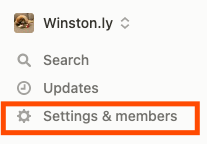
Click on the Members tab, where you can see whether you have admin-level access in your workspace.

If you don’t, reach out to your workspace owner, who can change your access level.
Connect Notion to Zapier
Whenever you’re ready to connect Notion in the Zapier editor, search for and select Notion as your app, then select the trigger, action, or search. Click Continue.
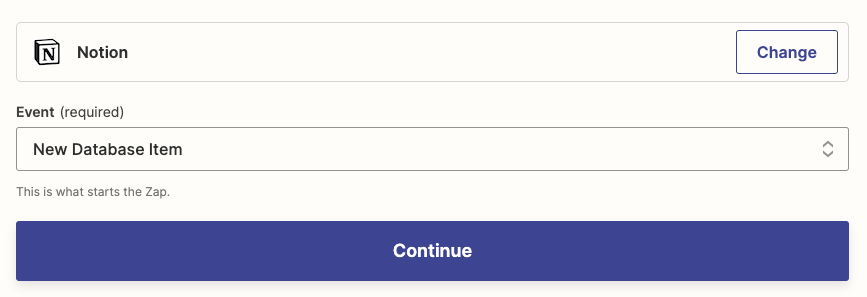
You’ll then be prompted to connect your Notion account. Click + Connect a new account. Zapier will prompt you to grant access to your workspace. Click Select pages.
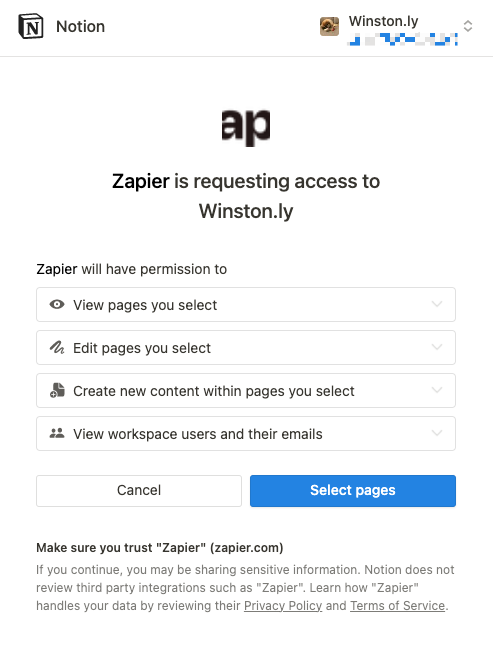
For each app you connect, Zapier will ask for a general set of permissions which allows you to be flexible with your Zaps. The only actions Zapier takes on your app accounts are those a given Zap needs to accomplish what you’ve set up.
Select the Notion pages you want Zapier to access, then click Allow access.
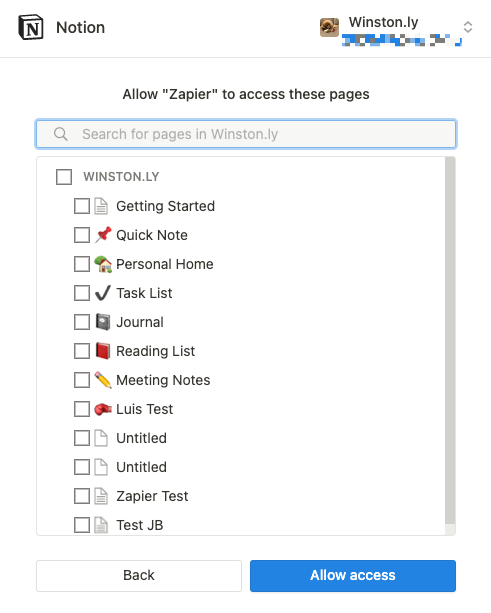
You’ve now connected your Notion account to Zapier!
Zapier will also appear in your list of connections within your Notion settings. Click on the My Connections tab to see the list of apps you’ve connected to your workspace.
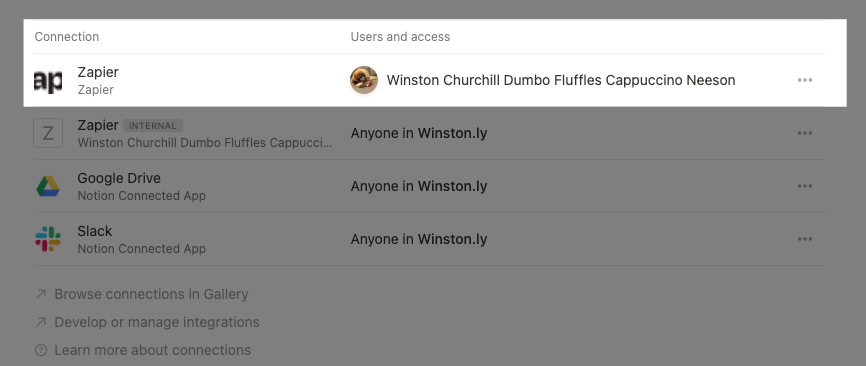
Popular ways to use Notion with Zapier
Notion combines the best of your favorite productivity tools into one app, but sometimes you still need information from outside apps. Zapier can help you turn your Notion workspace into a central hub for your most important information. Here are a few ideas to start:
To get started with a Zap template—what we call our pre-made workflows—just click on the button, and we’ll guide you through customizing it. It only takes a few minutes. You can read more about setting up Zaps here.
Keep up with your calendar
It can be tough to keep up with the daily demands of project deadlines, meetings, client calls, or anything else that relies on a calendar. Luckily, Notion allows you to visualize database items in a calendar or a timeline.
If you’re already using another calendar app to manage important dates, you can use a Zap to automatically send those calendar events to Notion. Get started with these workflows:
Stay on top of changes in Notion
When you’re working collaboratively in a shared workspace, it’s important for your team to know when something major has changed in your project plan.
Instead of relying on a human to notify the team—or trying spot the change on your own—these Zaps will automatically notify you in a team chat app whenever there’s a new database item in Notion.
If you’re working with external stakeholders, they’ll also need to be notified of major changes. Instead of giving them access to your workspace, you can use an automated workflow to draft an email for you.
Track tasks and projects
There are no shortage of project management and task apps to choose from. However, the one-size-fits-most approach of these tools might not jive with what you need to track work.
Notion allows you to customize and track your to-dos according to your style, whether it’s a list of checkboxes or you need multiple deadlines for a single task. But if your team manages projects in another app, you can create an automated workflow to add new tasks to your Notion workspace.
Get started with the Zaps below:
Share important emails
If you need to share an important email with your team, it’s a pretty manual process if you don’t have a shared inbox. Even with the wonderful invention of auto-forwarding, you still have to enter email addresses yourself.
Instead, you can use Zapier to automatically save the content of important emails in Notion.
Log anything you want
Whether you’re tracking brand mentions online, your published articles, or you just want to save interesting articles in one place, Notion is a great tool for logging your favorite links. Skip the copy-and-paste routine with these Zaps, which will automatically create Notion database items for you.
Organize customer information
Whether you’re trying to organize form submissions, spreadsheets, or invite attendees, it can be helpful to have that information in the same space where you do most of your planning. These Zaps will automatically create Notion database items for you, so you can keep tabs on your customers, without wasting time manually importing information.
Take your productivity to the next level with Notion and Zapier
This is just the start of all that you can do with Notion and Zapier. Zapier supports thousands of apps, so you automate almost any task at work. Create your Zap now and see what you can do.
New to Zapier? It’s an automation tool that helps anyone connect apps and automate workflows—without any complicated code. Sign up for free to use this app, and many others, with Zapier.
This article was originally published in May 2021 and was updated in November 2022 by Krystina Martinez.
Need Any Technology Assistance? Call Pursho @ 0731-6725516

